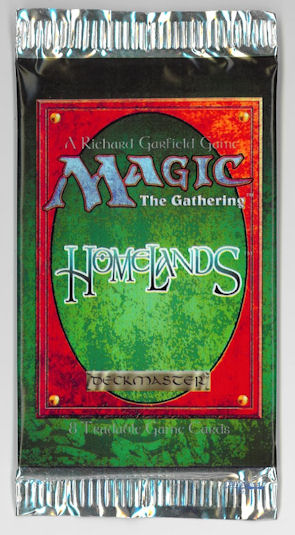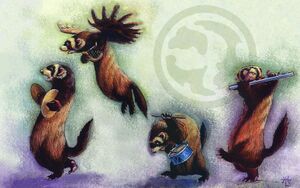Homelands: Difference between revisions
>Hunterofsalvation |
(→Set details: correcting the number of uncommons and rares, according to http://archive.wizards.com/magic/generic/cardlists/homelands_checklist.txt) |
||
| Line 27: | Line 27: | ||
''Homelands'' was developed as a separate expansion from the current [[Ice Age block]] at the time. <ref>{{DailyRef|mtg/daily/feature/157|Homelands: The Making of a Magic Expansion|[[Christopher Ferris]]|August 22, 2011}}</ref> The set introduced no new mechanics or keywords, but used some of the mechanics of ''Ice Age'', most notably the [[cantrip]] ability and single-color [[legendary]] [[creature]]s. Each color had at least one legend, with some colors having as many as five. The absence of mechanics found throughout the Ice Age block, such as [[Snow]] lands and [[cumulative upkeep]] and the fact that it didn't follow the Ice Age block storyline made it a poor fit in its former block. The [[expansion symbol]] of the set is a simplified globe of [[Ulgrotha]], the plane where ''Homelands'' was set. <ref>{{DailyRef|mtgcom/askwizards/1006|Ask Wizards|[[Brady Dommermuth]]|October 31, 2006}}</ref> | ''Homelands'' was developed as a separate expansion from the current [[Ice Age block]] at the time. <ref>{{DailyRef|mtg/daily/feature/157|Homelands: The Making of a Magic Expansion|[[Christopher Ferris]]|August 22, 2011}}</ref> The set introduced no new mechanics or keywords, but used some of the mechanics of ''Ice Age'', most notably the [[cantrip]] ability and single-color [[legendary]] [[creature]]s. Each color had at least one legend, with some colors having as many as five. The absence of mechanics found throughout the Ice Age block, such as [[Snow]] lands and [[cumulative upkeep]] and the fact that it didn't follow the Ice Age block storyline made it a poor fit in its former block. The [[expansion symbol]] of the set is a simplified globe of [[Ulgrotha]], the plane where ''Homelands'' was set. <ref>{{DailyRef|mtgcom/askwizards/1006|Ask Wizards|[[Brady Dommermuth]]|October 31, 2006}}</ref> | ||
The set's [[rarity]] breakdown is: 25 commons (25@C4), | The set's [[rarity]] breakdown is: 25 commons (25@C4), 45 Uncommons (26@U3, 19@C1), 45 Rares (45@U1). Each common card has 2 pieces of art, making collectors view this as a 140 card set. The art on all versions of the same card are illustrated by the same [[artist]]. | ||
''Homelands'' was probably the last set printed by [[Cartamundi]] in Belgium, because it was the last set to be printed on the 121-card [[print sheet]]s that were used by that firm. However, Cartamundi would later restart printing ''magic'' cards again later on. <ref>{{DailyRef|mtg/daily/feature/146|Building Tariel|[[Mark Purvis]]|June 6, 2011}}</ref> | ''Homelands'' was probably the last set printed by [[Cartamundi]] in Belgium, because it was the last set to be printed on the 121-card [[print sheet]]s that were used by that firm. However, Cartamundi would later restart printing ''magic'' cards again later on. <ref>{{DailyRef|mtg/daily/feature/146|Building Tariel|[[Mark Purvis]]|June 6, 2011}}</ref> | ||
Revision as of 02:52, 31 May 2015
- For other uses, see Homelands (disambiguation).
| Homelands | |
|---|---|
| Set Information | |
| Set symbol | |
| Themes and mechanics | None new |
| Keywords/ability words | None new |
| Set size | 115 (25 Common 47 Uncommon 43 Rare) |
| Expansion code | HML |
Homelands, released in October 1995, is the seventh Magic expansion. It was the second expansion of Ice Age block until July 2006, when it was replaced by Coldsnap in this role. Homelands is frequently panned as Magic's all-time low in game design, though it has also been praised for the quality of its setting and flavor.

Set details
Homelands was developed as a separate expansion from the current Ice Age block at the time. [1] The set introduced no new mechanics or keywords, but used some of the mechanics of Ice Age, most notably the cantrip ability and single-color legendary creatures. Each color had at least one legend, with some colors having as many as five. The absence of mechanics found throughout the Ice Age block, such as Snow lands and cumulative upkeep and the fact that it didn't follow the Ice Age block storyline made it a poor fit in its former block. The expansion symbol of the set is a simplified globe of Ulgrotha, the plane where Homelands was set. [2]
The set's rarity breakdown is: 25 commons (25@C4), 45 Uncommons (26@U3, 19@C1), 45 Rares (45@U1). Each common card has 2 pieces of art, making collectors view this as a 140 card set. The art on all versions of the same card are illustrated by the same artist.
Homelands was probably the last set printed by Cartamundi in Belgium, because it was the last set to be printed on the 121-card print sheets that were used by that firm. However, Cartamundi would later restart printing magic cards again later on. [3]
Marketing
Homelands is the last expansion to be printed on only two sheets and sold in eight-card booster packs (two cards from the uncommon sheet and six cards from the common sheet). Each booster bears the same green background image. Homelands was the first simultaneous international release. German, Spanish, French, Portuguese and Italian versions were being launched around the same time as the English version, and there were release events, called Magic:The Gathering I in New York City, Essen (Germany) and other locations.
Storyline
The planeswalker Feroz came across Ulgrotha, the once-beautiful plane now destroyed by the Wizards' Wars. At the last unspoilt oasis on this plane he met fellow planeswalker Serra, whom he married. Together they worked to restore the plane, and to protect it, Feroz's Ban was created. Feroz died during its creation, however, and the grief-stricken Serra abandoned the plane. In her absence the isolated civilizations of the plane fight amongst each other while the vampire Baron Sengir plots to take control of the plane under the fading Ban of Feroz.
Mechanics and themes
As mentioned, Homelands introduced no new mechanics. It had a number of themes, including a large number of real-world creature types, clockwork artifact creatures, Legendary creatures, and a number of "tribal" effects that enhanced only one creature type.
Homelands explored popular characters including Sengir and Serra and had a strong flavor, meaning that the cards were designed to fill specific roles. The flavor text on the cards can also be used to piece together parts of a story.
Creature types

Homelands, like many early expansions, has many creature types that are unique to the creatures they are found on. Many of these are real-world animals and types of people, grounding this expansion more in the real world than other expansions.
There are a few cards in this expansion that reference specific creature types, but most of these are not well supported, often with only one creature in this expansion with the referenced creature type. Those that are referenced are Dwarf, Faerie, Falcon (later changed to Bird), Hero, Minotaur, and Vampire. The best supported creature types were Minotaurs, Dwarves, and Faeries.
The following creature types are introduced in this expansion: Albatross (later changed to Bird), Alchemist (later changed to Cleric), Ambush Party (later changed to Rogue), Autocrat (later changed to Human), Badger, Bureaucrat (later changed to Advisor), Caravan (later changed to Nomad), Carriage (later changed to Horse), Constable (later changed to Human), Crusader (later changed to Knight), Ferret, Folk of An-Havva (later changed to Townsfolk), Hound, Inquisitor (later changed to Cleric), Lizard, Mist (later changed to Elemental), Narwhal (later changed to Whale), Noble (later changed to Faerie), Oyster, Pony (later changed to Horse), and Speaker (later changed to Cleric).
The following creature types are used in this expansion but also appear in previous sets: Bat, Bear, Bodyguard (later changed to Minotaur), Cleric, Dwarf, Faerie, Falcon (later changed to Bird), Fiend (later changed Horror), Gargoyle, Ghost, Hero (later changed to Soldier or Beast Soldier), Lycanthrope, Minotaur, Paladin (later changed to Knight), Serpent (later changed to Leviathan), Ship, Spider, Troll, and Wolf.
Design & Development
Homelands, on average, had an unexpectedly low power level compared to previously released expansions. The expansion was developed, as many of the earlier sets were, without much comunication between designers of various sets. It was developed with a flavor-first design philosophy, which, along with its separate story line, resulted in its strong difference from the Ice Age and Alliances expansions to which it was related in time. This flavor-first design also led to oddities in abilities. For example, many abilities were found in colors that normally do not receive them, such as flying in green or vigilance and trample in black, although this philosophy was not as developed in 1995 as it is today. Mark Rosewater wrote that "Homelands was a poorly designed set". [4]
Cycles
Homelands has one cycle:
- Tri-color land cycle: Uncommon lands with "
 : add
: add  to your mana pool.
to your mana pool.  ,
, : Add C to your mana pool.
: Add C to your mana pool.  ,
, : Add D or E to your mana pool." where D and E are the allied colors of C — Aysen Abbey, Wizards' School, Castle Sengir, Koskun Keep, and An-Havva Township.
: Add D or E to your mana pool." where D and E are the allied colors of C — Aysen Abbey, Wizards' School, Castle Sengir, Koskun Keep, and An-Havva Township.
Notable Cards
- Serrated Arrows saw tournament play not only as a result of the high prevalence of cards like Order of the Ebon Hand in Standard at the time, but also because of a short-lived rule requiring constructed tournament decks to include at least five cards from each legal set.
- Merchant Scroll, reprinted in Eighth Edition, is a blue tutor card that remains a passable card in many formats.
- Ihsan's Shade is among the iconic and flavorful legendary creatures of the set. Others include Autumn Willow, Eron the Relentless, and Baron Sengir.
- Memory Lapse, despite being unpopular at first, would go on to become considered one of the better cards in the set.
- Apocalypse Chime was the last expansion-hosing card to be printed.
- Timmerian Fiends was the last card to mention ante.
Trivia
References
- ↑ Christopher Ferris (August 22, 2011). "Homelands: The Making of a Magic Expansion". magicthegathering.com. Wizards of the Coast.
- ↑ Brady Dommermuth (October 31, 2006). "Ask Wizards". magicthegathering.com. Wizards of the Coast.
- ↑ Mark Purvis (June 6, 2011). "Building Tariel". magicthegathering.com. Wizards of the Coast.
- ↑ Mark Rosewater (November 10, 2003). "Make No Mistake". magicthegathering.com. Wizards of the Coast.